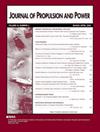Assessment of Pseudoshock Models Against Experiment in a Low-Aspect-Ratio Isolator
IF 2.4
4区 工程技术
Q2 ENGINEERING, AEROSPACE
引用次数: 0
Abstract
A highly confined shock train is investigated in a direct-connect isolator facility with a Mach 2 inflow and a constant-area low-aspect-ratio rectangular test section. High-speed schlieren imaging, wall static pressure measurements, surface oil-flow visualization, and particle image velocimetry from this isolator are synthesized into a three-dimensional schematic of the shock train structure. Against this, the prevailing pseudoshock models in the literature are assessed to evaluate the validity of their underlying assumptions. None of the prevailing pseudoshock models are found to simultaneously model the pressure and Mach number profiles, indicating a gap in the model formation and underlying assumptions when applied to the experimental isolator of interest. The presence of distortion in the isolator flowfield, such as a wall-bounded vortex, is found to skew the structure of the shock train, altering the strength and distribution of the compressive pressure gradient. It is further observed that the separated flow morphology surrounding the shock train is not monolithic, as is typically assumed, adjusting the balance of compressive forces within the shock cells. These findings lead to the conclusion that existing flux-conserved modeling approaches require modification to be effective in distorted and highly confined cases, including closure models that capture the three-dimensional distorted structure of the approach flow and its evolution along the shock train.低展弦比隔离器中伪激波模型的试验评估
在马赫数为2的直联式隔震装置中,研究了一个高度受限的冲击系,该装置具有恒定面积的低纵横比矩形试验截面。该隔离器的高速纹影成像、壁面静压测量、表面油流可视化和粒子图像测速技术被合成冲击列车结构的三维示意图。与此相反,对文献中流行的假冲击模型进行了评估,以评估其基本假设的有效性。没有发现任何主流的假冲击模型能够同时模拟压力和马赫数分布,这表明当应用于感兴趣的实验隔离器时,模型形成和基本假设之间存在差距。隔离器流场中存在的畸变,如壁面涡流,会使冲击系的结构偏斜,从而改变压缩压力梯度的强度和分布。进一步观察到,冲击系周围的分离流动形态并不像通常假设的那样是整体的,从而调节了冲击单元内的压缩力平衡。这些发现得出的结论是,现有的通量守恒建模方法需要进行修改,才能在扭曲和高度受限的情况下有效,包括捕捉引道流的三维扭曲结构及其沿冲击序列演变的闭合模型。
本文章由计算机程序翻译,如有差异,请以英文原文为准。
求助全文
约1分钟内获得全文
求助全文
来源期刊

Journal of Propulsion and Power
工程技术-工程:宇航
CiteScore
4.20
自引率
21.10%
发文量
97
审稿时长
6.5 months
期刊介绍:
This Journal is devoted to the advancement of the science and technology of aerospace propulsion and power through the dissemination of original archival papers contributing to advancements in airbreathing, electric, and advanced propulsion; solid and liquid rockets; fuels and propellants; power generation and conversion for aerospace vehicles; and the application of aerospace science and technology to terrestrial energy devices and systems. It is intended to provide readers of the Journal, with primary interests in propulsion and power, access to papers spanning the range from research through development to applications. Papers in these disciplines and the sciences of combustion, fluid mechanics, and solid mechanics as directly related to propulsion and power are solicited.
 求助内容:
求助内容: 应助结果提醒方式:
应助结果提醒方式:


